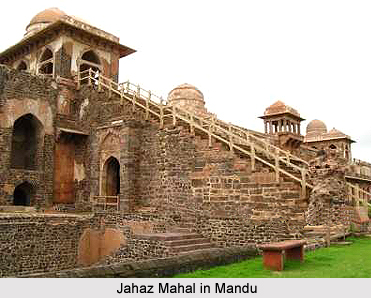 Jahaz Mahal in Mandu is one of the unique structures, which were built in the 15th century. Mainly used as the harem by Ghiyas- ud- din Tughlaq this palace was built mainly to station the women in the harem. This fort is mainly known for its unique architecture. This is placed between two most beautiful lakes known as Kapur talab and Munj talab, which are divided by the fort. The fort looks like a ship centered between these two lakes, which gives an impression as if it is floating between the lakes. Jahas mahal is a unique construction, which reflects the art and architecture of the past and also defines the romantic taste of the Muslim rulers.
Jahaz Mahal in Mandu is one of the unique structures, which were built in the 15th century. Mainly used as the harem by Ghiyas- ud- din Tughlaq this palace was built mainly to station the women in the harem. This fort is mainly known for its unique architecture. This is placed between two most beautiful lakes known as Kapur talab and Munj talab, which are divided by the fort. The fort looks like a ship centered between these two lakes, which gives an impression as if it is floating between the lakes. Jahas mahal is a unique construction, which reflects the art and architecture of the past and also defines the romantic taste of the Muslim rulers.
Known for its architecture this palace is shaped like a ship with two storeys. Mainly constructed as the harem of Ghiyas- ud- din, this palace has some exclusive bath chambers surrounded with glossy and decorative walls, an elaborate staircase, which leads to the roof, and a well built rooftop which provides exemplary view of the surrounding areas. Surrounded with some evergreen gardens and grass lands this provides ideal sight which attract all the tourists who visit the area with great expectations. While the terrace is surrounded with, number of kiosks and pavilions this palace shares one of the richest scenic beauties of the surrounding areas.
The ground floor of Jahaz Mahal consists of three large halls, with corridors in between and narrow rooms at the extreme ends, and a beautiful cistern beyond the northern room surrounded by a series of columns on its three sides. A pavilion projects over the Munj tank at the back of each hall having domical ceiling decorated with a band of blue and yellow tiles. The southern end of Jahaz Mahal has an area having water channel from which, it looks like, and the cistern at the other end received its supply of water. The cistern is beautifully designed and has a landing below the top margin for those not knowing to swim. In the southeast corner of the Southern Pavilion, a water-lift supplied water to the open bath at the northern end through a water channel running along the front terrace of Jahaz Mahal. Following a different style from other buildings, the surfaces of the walls and roofs of the Jahaz Mahal are covered with a thick coat of plaster, a feature that is also visible on entire facade of the front building.






